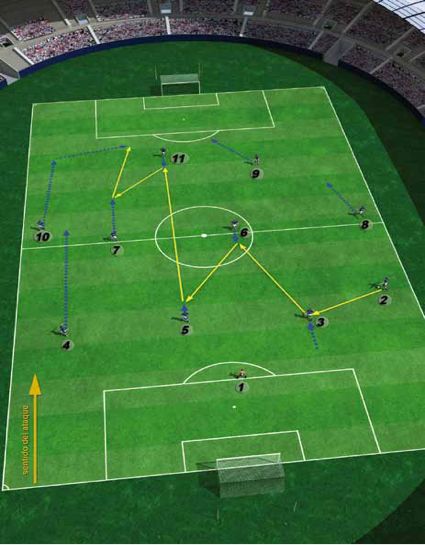In relation to the game between three lines (triangulations), there are three possible combinations of triangulation:
The player receiving the ball on the first pass:
If the marking is zonal, the receiver will simply look for the pass line behind its marker so that it will be rotated directly when it has passed it (it will therefore not be necessary to triangulation).
|
Scheme

Considerations
In the offensive game with the short (positional) style of play, after keeping the ball collectively, we must make progress. This requires the participation of the three game lines (triangulations/line relationship,...). Other than that, it will be very difficult to overcome the collective defensive structure of the opposing team in the start and progression sub-phases.
Playing in progression (from one line to another), if not successful, will allow the interception of the ball by opposing defenders if they are correctly placed.
In-game between 3 lines (triangulations):
- We consider that triangulation occurs when there are two or more walls (made at a touch), between different players of different lines.
- When in a lane there are 2 or 3 touches between lines the attention and orientation of the opposite are directed towards the demarcations of this lane, creating large spaces in the other two lanes. For this reason it is important that both the 2nd and third passes of the triangulation are oriented to the opposite side from which the ball comes in the 1st.
- The most effective way to overcome opposing opposition in the progression zone (where most of a team's losses occur) is to relate offensive play to the participation of all three lines of play. The LA must be offered constantly (playing with its back to the opposite goal) when the ball is controlled by an LD teammate.
- In 3-touch triangulations, in the latter of them the ball must be played in depth towards the free spaces left by the opposite. These balls must be "searched" by LM and/or LD players in the lane to which the ball is going, and who have not participated in triangulation.
Aimed at
The player who intends to progress in the collective game, in the Home and Progression sub-phases
Training Goals
Do not lose possession of the ball in the realization of the Associative/Positional style of play
Video
VIDEO (FUP5i): The pass between 3 game lines INCORRECT MANIFESTATION
VIDEO (FUP5c): The pass between 3 lines of play MANIFESTATION CORRECT
